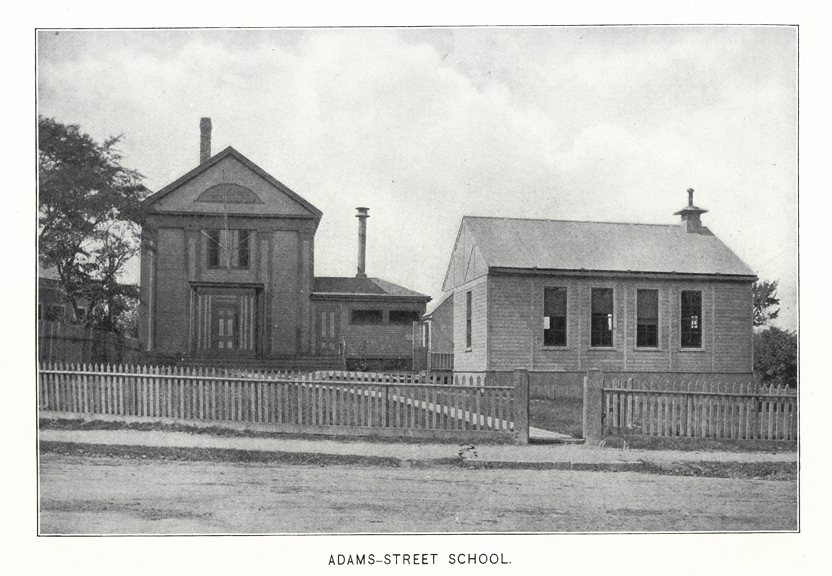Dorchester Illustration no. 2346 Adams Street School, Cedar Grove
Today’s illustration has been provided by the Boston City Archives.
Have you ever wondered if an earlier building may have been located on your lot before your house was built?
Next to Cedar Grove Gardens there is a little street called Joanne Terrace with houses that were built during the period from 1950 to 1960. The 1933 atlas shows that the tract of land that contains 903 and 907 Adams Street plus 1, 2, 5, 6, 9 and 10 Joanne Terrace was a vacant rectangular parcel owned by the City of Boston.
The 1882 through 1918 atlases show that there was a primary school here, named at first the Codman School and later the Adams Street School. That is the subject of today’s illustration. The 1904 atlas shows the footprints of the two buildings seen in the illustration, but the earlier and later atlases do not. My guess is that the reason the illustration appeared in the 1902 School Committee Report was due to the construction of the small building at the right, which served some temporary purpose.
The earlier story of the site is a bit macabre. The land appears to have been vacant until Daniel Pierce constructed a cabinet shop and other buildings there in the early 19th century. The 1850 map has a symbol for a factory at this location. Furniture dealers Abraham and John Kimball bought the property from Pierce in 1865, but they sold to John McBride in 1867. John McBride’s heirs sold the property the same year to George McBride. George operated a Cotton Drying Works in the buildings, probably after refitting them for the operation of the business.
The description of the property used by the business was that there were seven wooden buildings. The main building was one and a half stories high in the form of a “T”. The top was 50 feet by 39 feet, where bales were opened, the sorting was done and the cotton was placed on racks to dry. The heat necessary for the drying process was supplied by 10,000 feet of one-inch steam pipes laid between the floors. When the factory was busy, it employed as many as thirty to forty people.
On March 3, 1870, the Boston Post reported that a fire the day before had destroyed the Neponset Drying Works burning six women employees to death. Three men were at work on the lower floor, and the six women were sorting on the second. No cause was ever determined for the fire. “Of course all the efforts which could possibly be made were instantly put forward to rescue the women; but the majority of them must have been suffocated before the fire was discovered. Only one was visible after that time, and she quickly disappeared as the devouring flames, finding the best of fuel in the well dried wood, swept through the windows, encircled the roof and passed on to the drying house, which fed an easy prey to the strong body of blaze behind it. Nothing could be done for the unfortunate women; the heat repelled all advances, and small need was there of an attempt, for there was not a single chance of finding life in the building after the flames appeared at the windows. A half hour had elapsed and the burning pile was mostly consumed before the fire engines made an appearance.”
Robert Vose, the coroner, convened a jury of inquest. The verdict was death by fire, &c., cause unknown. The women who died were Ellen Dunn aged 25 (no residence indicated), Margaret Kennedy aged 34 (North Quincy), Mary Hurley aged 45 (Neponset), Bridget Martin aged 25 (North Quincy), Bridget Martin aged 38 (Cambridge), and Margaret Cunniff aged 30 (Glover’s Corner). The remains were transferred to Cedar Grove Cemetery from which they were later taken to be buried in St. Mary’s Cemetery in West Quincy. There is no marker.
The City of Boston purchased the lot from George McBride in September 1872 for $6,669. It is probable the school building was constructed in the later 1870s.

